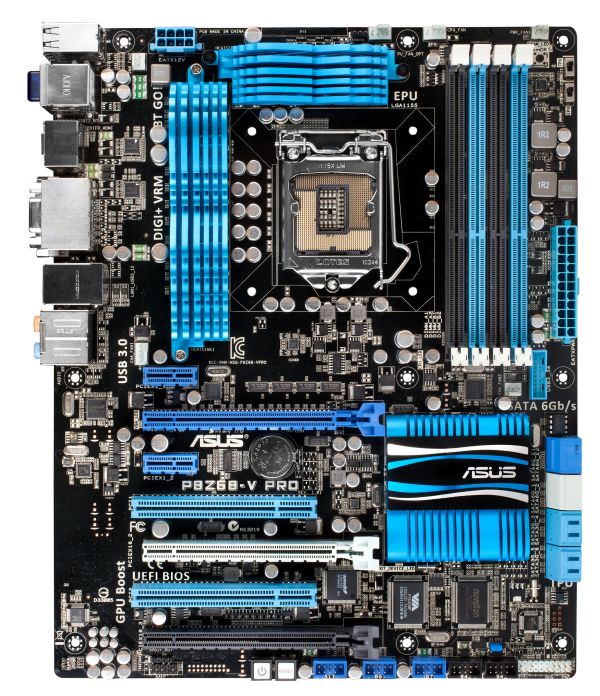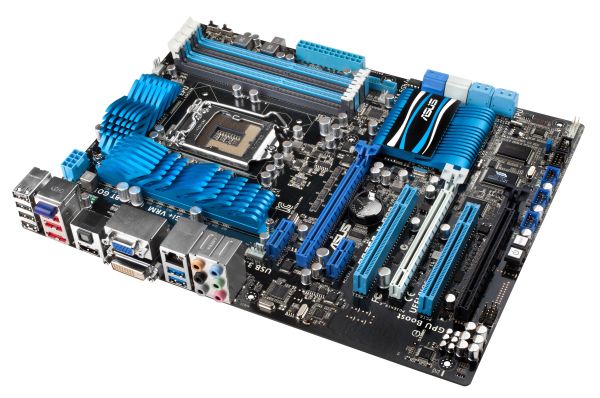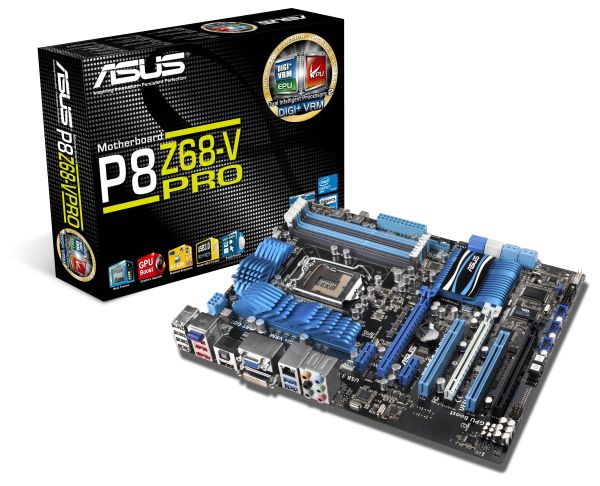ASUS P8Z68-V PRO Review: Our First Z68 Motherboard
by Ian Cutress on May 11, 2011 3:13 AM EST- Posted in
- Motherboards
- Asus
- Z68
ASUS P8Z68-V PRO: Overview
This board from ASUS is a great all-round performer, compared to the P67 boards we have reviewed—space for tri-GPU setups, six fan headers with good OS fan controls, eight SATA ports, six with RAID 0/1/5/10, Intel gigabit Ethernet and it performs well in our benchmark suite. The goods bundled in the box aren't the best we've seen, especially for an expected retail price of $210. But this is a Z68 board—the seemingly logical progression Intel have taken to combine the best bits of P67 and H67, in terms of overclocking. It's thanks to software solutions such as LUCIDLOGIX's Virtu that we can harness both the integrated GPU and discrete GPUs for different work loads—I detail my experiences with Virtu in this review.
ASUS P8Z68-V PRO: Visual Inspection
A quick look at the P8Z67-V PRO board and you might be joining me in thinking it looks almost identical to the P8P67 PRO motherboard. The blue, black and grey livery is still here, with those blue wavy heatsinks covering up the 12 phase CPU and 4 phase iGPU power delivery—unlike other boards, these aren't joined by a heatpipe, and the larger heatsink has a pretty substantial plate connecting the ends on the back of the board.
Around the socket itself, there is one 4-pin chassis fan header near the PCIe 1x, one PWR 3-pin near the 12V CPU power connector, and two CPU fan headers (one 4-pin, one 3-pin) to the top right, which should cover any all-in-one cooling solution with a dual fan and water pump arrangement. Unlike some other Cougar Point motherboards, ASUS have located the PCH to below the DIMM slots, under a large flat heatsink which gets quite warm to touch under normal operation.
Alongside the DIMM slots we have another 3-pin PWR fan header in the top right, just above ASUS' EPU and TPU switches, which activate their Energy Processing Unit and TurboV Processing Units respectively, for lower power usage or automatic overclocking. Enabling both could lead to system instability, however. Underneath these, beyond the 24-pin ATX power connector is a a 3-pin chassis fan header and the USB 3.0 19-pin header. As this is placed here, you would assume ASUS are thinking everyone will be using this header to power a USB 3.0 bracket in the front of the case, rather than the rear. But the supplied USB 3.0 bracket is designed for the rear of the board and doesn't stretch that far, especially over a dual slot GPU should one be in use.
The SATA ports are similar to that found on the P8P67 Pro—the four SATA 3 Gbps from the PCH are in blue, the two SATA 6 Gbps from the PCH are in white, and two SATA 6 Gbps from a Marvell controller. Rather than place the Power/Reset buttons underneath the SATA ports, they are found amongst the myriad of USB and IEEE 1394 headers along the bottom of the board, making them very inconvenient if all three full-size PCIe slots are occupied with dual slot cards.
The PCIe slot arrangement is standard—enough space at the top for a full length PCIe x1 card, with a PCIe x16 slot underneath with a triple slot gap to the next PCIe x16. The three full length PCIe slots run in x16/x0/x4 or x8/x8/x4 mode for GPU setups. However, the bottom PCIe slot shares bandwidth PCIe x1 slots, a two USB ports in the IO panel and the eSATA IO port—all of these are inactive if the bottom PCIe is in x4 mode. By default, the PCIe is in x1 mode, and requires a BIOS setting change for x4.
The IO panel for Z68 boards supporting integrated graphics is a combined mix of previous P67 and H67 iterations, and as such we either lose legacy connections or USB ports infavor of video out ports. There's no PS/2 legacy connector—instead we have on the far left four USB 2.0 ports, then another two USB 2.0 ports, the eSATA 3 Gbps port powered by a JMicron JMB362 controller, and a Bluetooth module. These red USB 2.0 ports/eSATA port are the ones disabled when the third PCIe is in x4 mode. In terms of video outputs, we have a HDMI, DVI and VGA—no display port here, instead you get an optical S/PDIF out (which also means no coaxial S/PDIF out). Just a single gigabit Ethernet port powered by an Intel 82579, and a pair of USB 3.0 ports powered by ASMedia controller. Standard Realtek ALC892 8-channel audio is also present.














95 Comments
View All Comments
BernardP - Wednesday, May 11, 2011 - link
A practical question: If one wants to use i-mode or d-mode, is it necessary to install both the Intel video driver and the AMD or Nvidia video driver?Could this be a source of conflicts or other problems?
AnnihilatorX - Thursday, May 12, 2011 - link
Yes you need to install both. Not really on Vista and Windows 7, new driver models mean you can install multiple GPU drivers. I don't think Virtu supports older OS.BernardP - Thursday, May 12, 2011 - link
Thanks for the reply. Noted for future. After taking everything into consideration, including my usage pattern, I would simply deactivate intel IGP, not install Virtu and add an entry-level Nvidia videocard, such as the fanless Asus GT 520.The noteworthy other Z68 feature is SSD cache, but after reading the detailed article about this, I would prefer to go with a 120 GB SDD plus mirroring HDDs.
For me the single plus of the Z68 platform is that I would have Intel IGP as a temporary backup in case of failure of the discrete GPU. This is only worth a very small premium over P67.
vol7ron - Wednesday, May 11, 2011 - link
When you refer to BIOS, do you mean the UEFI BIOS Utility, or is there a dual BIOS/UEFI boot option?risa2000 - Wednesday, May 11, 2011 - link
I noticed in test setup description three different memory modules. Did you do some tests on memory throughput? Was there any difference?I wonder if it makes sense to go for faster memory beyond DDR3-1600.
AnnihilatorX - Thursday, May 12, 2011 - link
You are looking at about 2-5% performance increase from going DDR 1600 to DDR 2133No point buying expensive RAM unless you spot a bargain
L. - Thursday, May 12, 2011 - link
"expensive RAM" -- on the other hand there's quite a lot of relatively cheap around 2k mhz -- sticking to 1600 isn't that great nowadays.cyklonman - Wednesday, May 11, 2011 - link
P67 Asus looks much better, why did I wait for this one?fr500 - Wednesday, May 11, 2011 - link
Will this work?Hook up a monitor with two inputs and connecting a spare input to the motherboard's connector? As far as I know all you need is a display hooked up to one of the motherboard connectors, so if you have a display with 2+ inputs you could get one to your IGP, one to your GPU and switch to the IGP input when you want to do transcoding.
Best of both worlds, intact GPU performance and Quicksync.
Even if Virtu works 100% it still won't let you use your GPU control panel and any crashes might be harder to diagnose (ie: who should I blame, Lucid or NVidia/AMD)
Ryan Smith - Thursday, May 12, 2011 - link
Sure, that should work. Windows may or may not have quirks though, based on past experience.As for the control panel thing, I have not used Virtu in dGPU mode, but based on how Hydra works I'm sure the AMD/NV control panels work in dGPU mode. I wouldn't expect any crashes in that mode either since Virtu isn't intercepting the dGPU, but again I classify that with the fact that I haven't used dGPU mode yet.